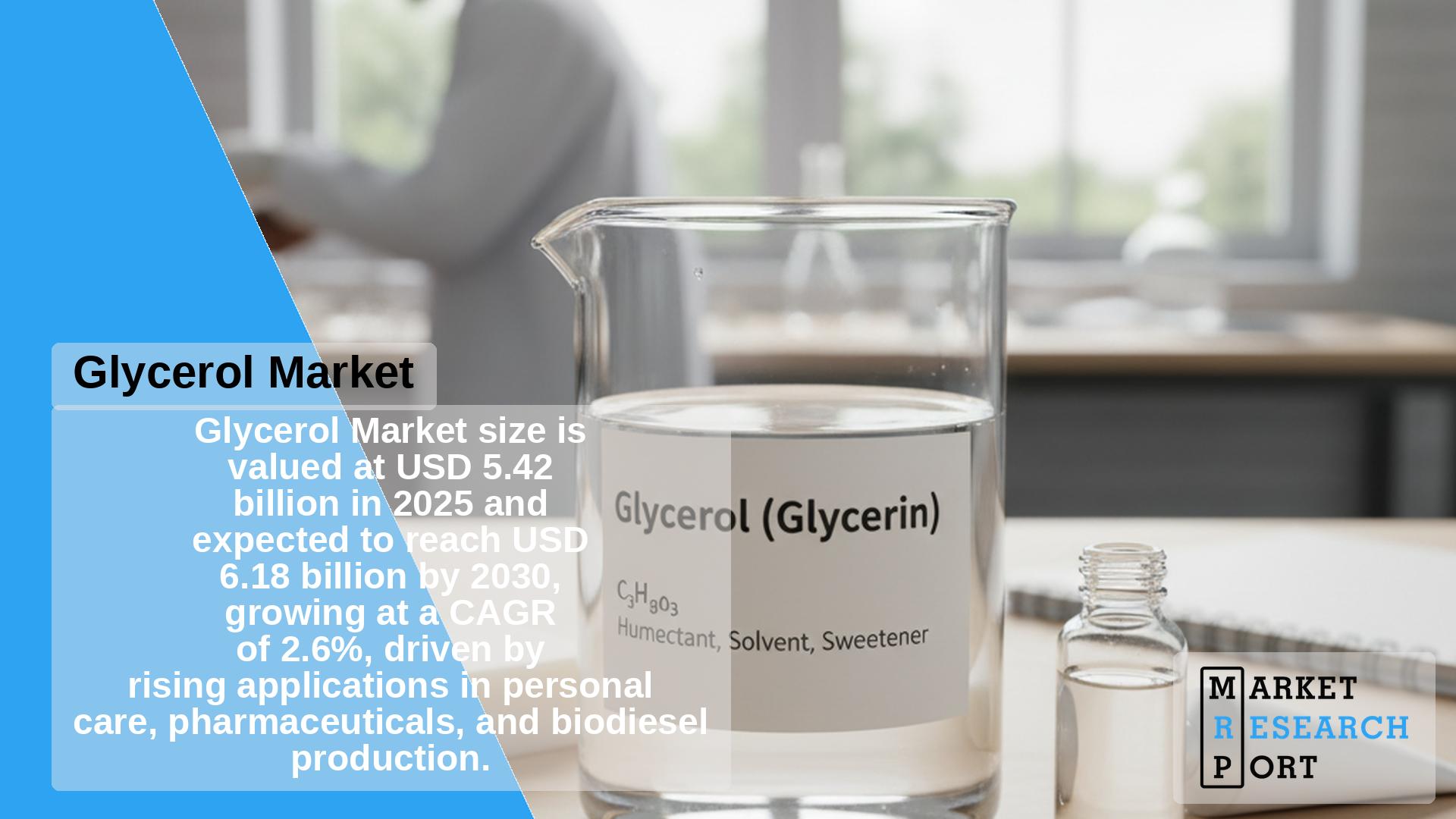
The global glycerol market was valued at USD 5.42 billion in 2025 and is projected to reach USD 6.18 billion by 2030, growing at a CAGR of 2.6% during the forecast period. Demand growth is largely driven by its extensive applications in personal care, pharmaceuticals, food, and nutraceutical products, combined with the increasing production of biodiesel where glycerol is obtained as a by-product.
Glycerol, also known as glycerin, is widely used due to its non-toxic, biodegradable, and hygroscopic nature. It serves as an important raw material in various industries ranging from food and beverages—where it functions as a humectant and sweetener—to pharmaceuticals and cosmetics, where it enhances moisture retention and texture. Growing consumption of fortified foods, nutraceuticals, and eco-friendly cosmetic products is propelling market demand across emerging economies.
Industrial production of glycerol occurs through transesterification and hydrolysis of fats and oils, often as a by-product of biodiesel. Refining technologies have advanced to convert crude glycerol more efficiently into high-purity refined grades suitable for commercial usage. However, fluctuations in raw material costs, including vegetable oils and methanol, remain a key challenge affecting pricing trends.
The biodiesel segment continued to hold the largest revenue share in 2025, accounting for 61.3% of total production. The rising manufacture of biodiesel as a sustainable energy source enhances the availability of glycerol as a by-product. Its cost efficiency and stable feedstock make biodiesel-derived glycerol highly preferable across industries.
The soap segment sustained a strong share due to increasing demand from detergent and personal care applications, where glycerin improves skin softness and hydration. Meanwhile, fatty alcohols emerged as the fastest growing source category at a CAGR of 3.1%, supported by diversified use in surfactants, emulsifiers, and household cleaning products.
Refined glycerol remained the largest product category, contributing 76.2% of global share in 2025, due to its high solubility, purity, and broad usage in cosmetics, pharmaceuticals, and food applications. Refined products underwent further purification to remove impurities such as salts and methanol, enabling diverse industrial use.
Crude glycerol maintained a secondary but important role in feedstock and chemical intermediate applications. Although crude glycerol contains higher contaminants, advancements in cost-effective purification techniques are supporting its gradual industrial adoption in biofuels and livestock nutrition.
The personal care and cosmetics segment dominated the global market in 2025, accounting for 42.5% of total consumption. Expanding usage in skincare, oral hygiene, and natural beauty products has positioned glycerol as a critical moisturizing and emulsifying ingredient. Rising consumer preference for sustainable and plant-based products is further amplifying its utilization.
The pharmaceutical segment exhibited a steady CAGR of 3.0%, with glycerol being actively used in cough syrups, toothpaste, and external ointments due to its lubricative and therapeutic properties. Other applications, including food & beverage, industrial lubricants, and explosives manufacture, remained consistent contributors to global consumption.
Asia Pacific continued to dominate the global glycerol market, led by high biodiesel output and robust growth in cosmetics and packaged food sectors. China, India, and Indonesia are emerging as crucial hubs for sourcing vegetable oil-based glycerol, benefiting from costlier petroleum substitutes. Growing urbanization and higher consumer awareness regarding personal care have further supported regional growth.
Europe remained the second-largest regional market in 2025, supported by stringent biofuel regulations and high export potential for refined glycerin. Germany, the Netherlands, and France lead in biodiesel and oleochemical integration, fostering steady glycerol supply growth. In North America, growing adoption in pharmaceuticals, beverages, and industrial uses continues to sustain demand.
In Central & South America, Brazil and Argentina serve as key export hubs, supported by large-scale biodiesel refineries and a well-established chemical export network.
The global glycerol market is moderately consolidated, characterized by vertically integrated multinational producers and local refineries. Leading manufacturers focus on process innovation, global expansion, and partnerships with oleochemical producers. Sustainability commitments and large-scale R&D investment are shaping competitive strategies in 2025.
| Report Attribute | Details |
| Market size value in 2025 | USD 5.42 billion |
| Revenue forecast in 2030 | USD 6.18 billion |
| Growth rate | CAGR of 2.6% from 2025–2030 |
| Historical data | 2019–2024 |
| Forecast period | 2025–2030 |
| Quantitative units | Revenue in USD billion, volume in kilotons, CAGR from 2025 to 2030 |
| Report coverage | Market forecasts, company ranking, competitive dynamics, key trends |
| Segments covered | Source, product, application, region |
| Regional scope | North America; Europe; Asia Pacific; Central & South America; Middle East & Africa |
| Country scope | U.S.; Canada; Germany; India; China; Japan; Brazil; Argentina; Saudi Arabia; South Africa |
| Key companies profiled | Cargill, Incorporated; BASF SE; Procter & Gamble; Dow; KLK OLEO; Oleon NV; ADM; Wilmar International Ltd.; Godrej Industries; Emery Oleochemicals; CREMER OLEO GmbH & Co. KG |
How large is the global glycerol market in 2025?
The market was valued at USD 5.42 billion in 2025.
What is the expected growth rate of the glycerol market?
The market is anticipated to grow at a CAGR of 2.6% between 2025 and 2030, reaching USD 6.18 billion.
Which source dominated the glycerol market?
The biodiesel segment accounted for the largest share of 61.3% in 2025, resulting from its by-product generation during biodiesel processing.
Who are the main players in the glycerol market?
Prominent companies include BASF SE, Cargill, Procter & Gamble, Dow, KLK OLEO, and Wilmar International Ltd.
What factors drive the global glycerol market?
Key drivers include rising demand across cosmetics, personal care, and pharmaceuticals; expanding biodiesel production; and the increasing preference for renewable, non-toxic materials in manufacturing processes.